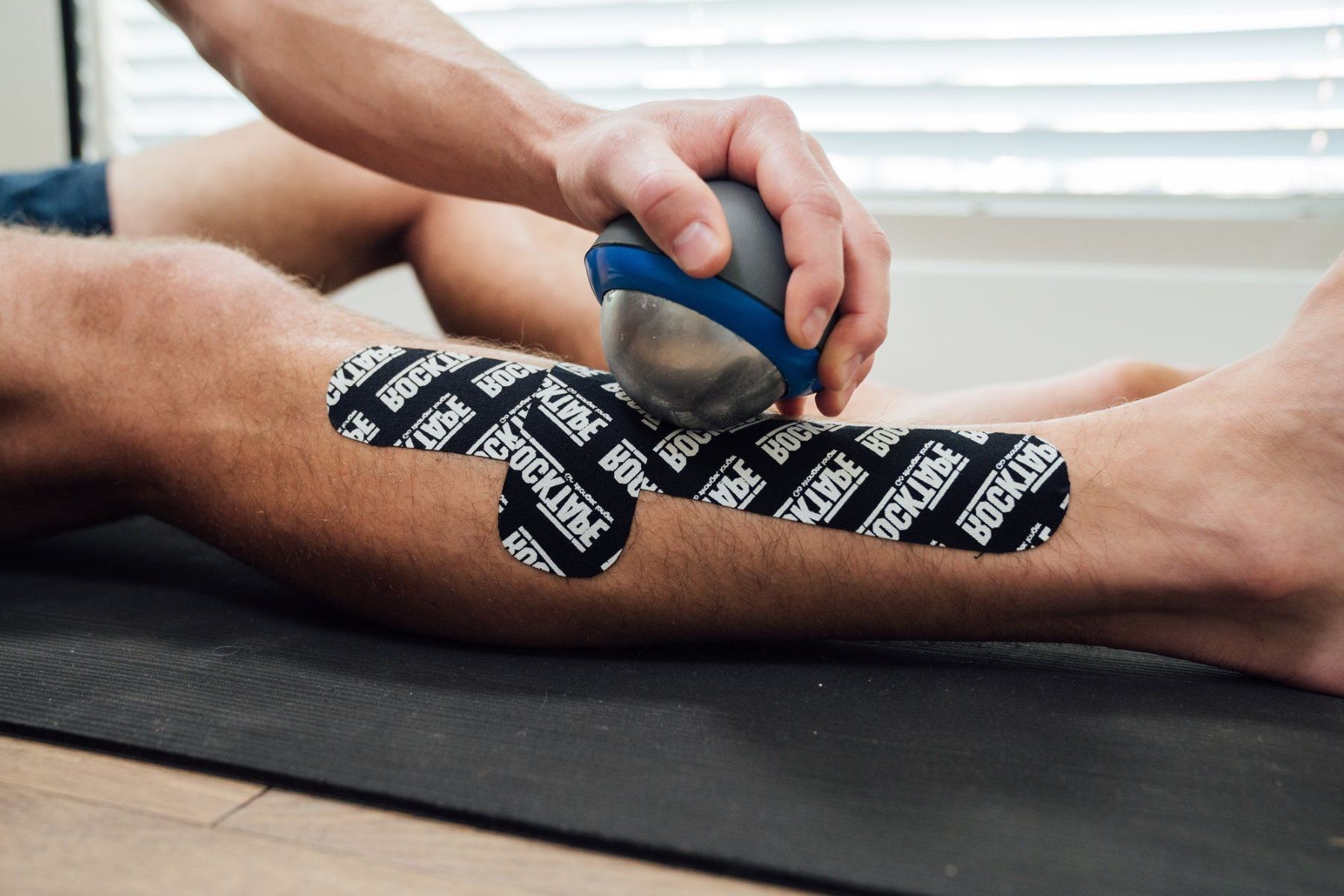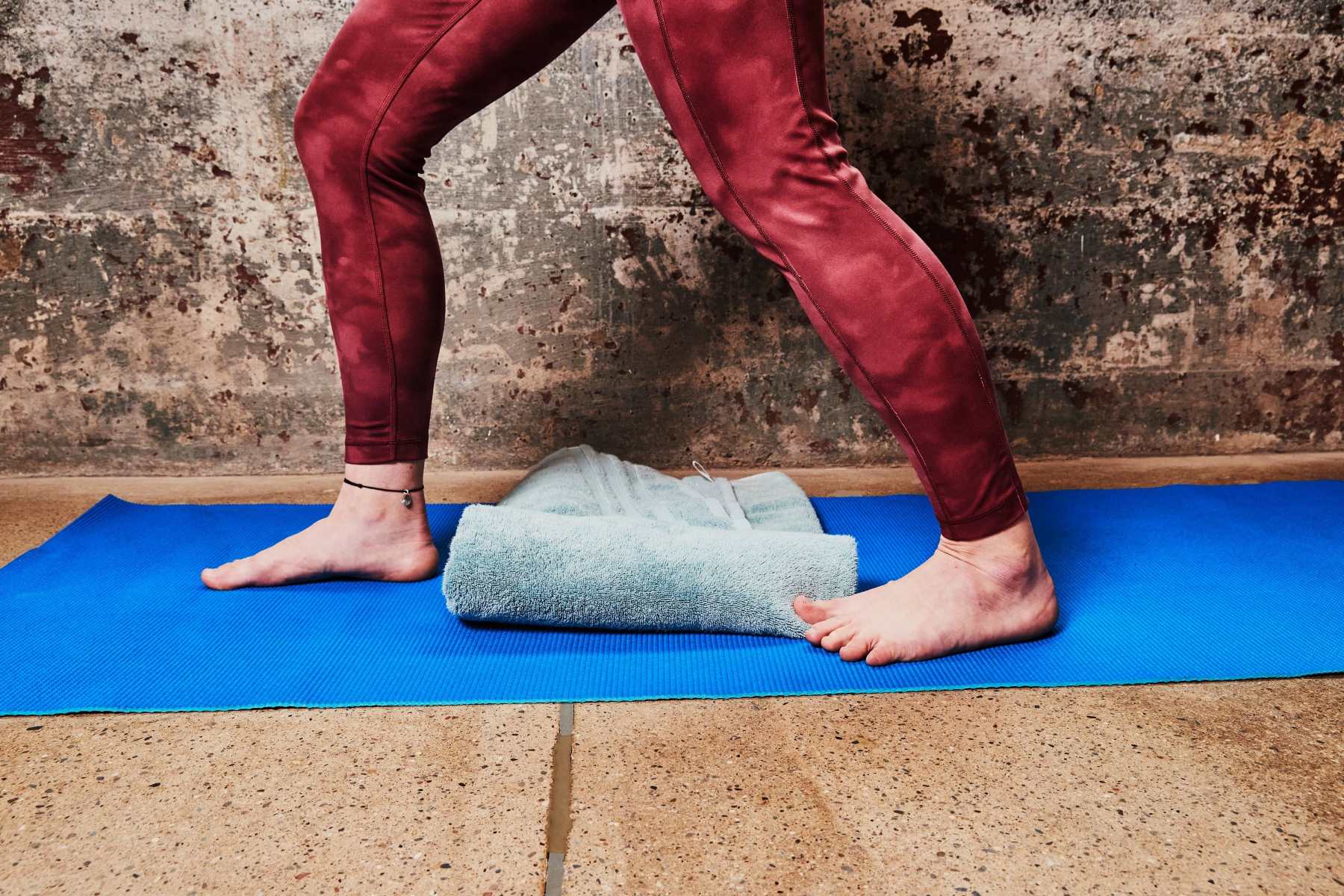Home>Health & Nutrition>Injury Prevention>How To Use KT Tape For Shin Splints


Injury Prevention
How To Use KT Tape For Shin Splints
Published: February 25, 2024
Learn how to use KT Tape for shin splints to prevent injuries and support your shins during physical activities. Follow our step-by-step guide for effective injury prevention.
(Many of the links in this article redirect to a specific reviewed product. Your purchase of these products through affiliate links helps to generate commission for Therunningadvisor.com, at no extra cost. Learn more)
Table of Contents
Understanding Shin Splints
Shin splints, medically known as medial tibial stress syndrome, are a common lower leg injury that affects athletes, runners, dancers, and individuals who engage in high-impact activities. This condition is characterized by pain along the inner edge of the shinbone (tibia) and is often caused by repetitive stress on the shinbone and the tissues attaching the shinbone to the muscles surrounding it.
Shin splints typically result from overuse, improper training techniques, or wearing inadequate footwear. The excessive force placed on the shinbone and connective tissues can lead to inflammation, discomfort, and tenderness in the affected area. It's essential to recognize the early signs of shin splints, such as a dull ache or sharp pain during physical activity, as prompt intervention can prevent the condition from worsening.
Individuals with flat feet or high arches, as well as those with muscle imbalances or inadequate flexibility, may be more susceptible to developing shin splints. Moreover, sudden changes in physical activity, such as increasing the intensity or duration of workouts too rapidly, can also contribute to the onset of this condition.
Understanding the underlying causes of shin splints is crucial for implementing effective preventive measures and treatment strategies. By addressing the root factors that contribute to the development of shin splints, individuals can minimize the risk of experiencing this debilitating condition and optimize their overall physical well-being.
In the subsequent sections, we will delve into the benefits of using KT Tape for shin splints, providing a comprehensive guide to preparing the skin for KT Tape application, and offering valuable tips for maximizing the effectiveness of KT Tape in managing shin splints. Additionally, we will outline the circumstances in which seeking professional assistance for shin splints is advisable, empowering individuals to make informed decisions regarding their health and injury prevention.
Benefits of Using KT Tape for Shin Splints
KT Tape, also known as kinesiology tape, has gained widespread recognition for its therapeutic benefits in managing various musculoskeletal injuries, including shin splints. When applied correctly, KT Tape can offer several advantages in alleviating discomfort, promoting healing, and supporting the affected area. Here are the key benefits of using KT Tape for shin splints:
-
Pain Relief: KT Tape provides targeted support to the muscles and connective tissues surrounding the shin, which can help reduce pain and discomfort associated with shin splints. The gentle pressure applied by the tape may alleviate strain on the affected area, allowing individuals to engage in physical activities with greater ease.
-
Enhanced Circulation: By applying KT Tape to the affected region, individuals may experience improved blood circulation, which can facilitate the delivery of oxygen and nutrients to the injured tissues. Enhanced circulation is essential for promoting the body's natural healing processes and accelerating recovery from shin splints.
-
Support and Stability: KT Tape offers a non-restrictive form of support, aiding in the stabilization of the shin and surrounding muscles. This added stability can help prevent excessive movement and stress on the injured tissues, reducing the risk of exacerbating the condition during physical exertion.
-
Reduced Swelling: The application of KT Tape may assist in minimizing swelling and inflammation in the affected area. By providing gentle compression, the tape can help manage fluid buildup and promote a more comfortable environment for the healing process to take place.
-
Improved Range of Motion: KT Tape is designed to be flexible and elastic, allowing for a full range of motion while providing support. This feature is particularly beneficial for individuals with shin splints, as it enables them to engage in activities that require movement without compromising the stability of the affected area.
-
Non-Invasive Treatment Option: Unlike certain medical interventions, KT Tape offers a non-invasive approach to managing shin splints. The tape can be applied externally, offering a convenient and accessible treatment option for individuals seeking relief from shin splint symptoms.
-
Psychological Support: Beyond its physical benefits, KT Tape can also provide psychological reassurance to individuals coping with shin splints. The visible application of the tape serves as a tangible reminder of the support and care being provided to the affected area, potentially boosting confidence and mental resilience during the recovery process.
Incorporating KT Tape into a comprehensive injury prevention and management plan can contribute to a holistic approach to addressing shin splints. It is important to note that while KT Tape can offer valuable support and relief, individuals with persistent or severe shin splint symptoms should seek professional medical guidance to ensure appropriate care and treatment.
By harnessing the benefits of KT Tape, individuals can take proactive steps to manage shin splints and promote their overall well-being, enabling them to pursue their physical activities with greater comfort and confidence.
Preparing the Skin for KT Tape Application
Properly preparing the skin before applying KT Tape is essential to ensure optimal adhesion, comfort, and effectiveness. By following these preparatory steps, individuals can create an ideal surface for the application of KT Tape, maximizing its benefits in managing shin splints.
Clean and Dry the Skin
Before applying KT Tape, it is crucial to cleanse the skin thoroughly to remove any dirt, oils, or lotions that may hinder the tape's adherence. Gently wash the targeted area with mild soap and water, ensuring that the skin is free from residue and completely dry before proceeding with the application. This step helps promote strong adhesion and prevents the tape from peeling or slipping during physical activity.
Shave or Trim Body Hair
For individuals with excessive hair in the area where KT Tape will be applied, it is advisable to trim or shave the hair to facilitate proper adhesion. Hair can interfere with the tape's ability to adhere securely to the skin, potentially compromising its effectiveness. By maintaining a smooth surface, the tape can adhere more firmly, ensuring consistent support and stability during movement.
Avoid Overstretching the Skin
When preparing the skin for KT Tape application, it is important to refrain from excessive stretching or pulling of the skin. Overstretching the skin can lead to discomfort and may affect the tape's ability to adhere evenly. Instead, maintain a relaxed and natural position while preparing the skin, allowing for a comfortable and secure application of the tape.
Assess Skin Sensitivity and Irritation
Individuals with sensitive skin or a history of skin irritation should perform a patch test with a small piece of KT Tape before full application. This precautionary measure helps identify any potential adverse reactions and allows for adjustments to be made, such as using hypoallergenic tape or applying a protective barrier, to minimize the risk of skin irritation.
Allow the Skin to Acclimate
After completing the preparatory steps, it is beneficial to allow the skin to acclimate to the environment to ensure optimal tape adhesion. This can be achieved by waiting a few minutes to allow any residual moisture to evaporate and the skin to reach a stable, dry state, creating an ideal surface for the application of KT Tape.
By meticulously preparing the skin for KT Tape application, individuals can enhance the tape's adherence and comfort, setting the stage for effective support and relief in managing shin splints. These preparatory measures contribute to a successful application, enabling individuals to experience the full benefits of KT Tape in addressing shin splint symptoms and promoting active, pain-free movement.
Step-by-Step Guide to Applying KT Tape for Shin Splints
Applying KT Tape for shin splints requires precision and attention to detail to ensure optimal support and comfort. By following this step-by-step guide, individuals can effectively apply KT Tape to the affected area, harnessing its therapeutic benefits in managing shin splints.
Step 1: Measure and Cut the Tape
Begin by measuring the required length of KT Tape based on the targeted area. Using scissors, carefully cut the tape to the appropriate size, ensuring rounded edges to prevent premature peeling.
Step 2: Prepare the Skin
Following the preparatory steps outlined earlier, cleanse and dry the skin thoroughly, and if necessary, trim or shave any excess hair to facilitate proper adhesion.
Step 3: Positioning for Support
Identify the specific area of the shin affected by shin splints. With the individual in a relaxed position, such as sitting or standing with the foot flat on the ground, determine the optimal positioning for applying the KT Tape to provide support and relief.
Step 4: Apply the Base Strip
Starting with the base strip, gently remove the backing from the KT Tape and apply it along the inner edge of the shin, just above the ankle. Ensure that the tape adheres smoothly to the skin without any wrinkles or folds, providing a stable foundation for the subsequent strips.
Read more: How Collagen Can Benefit Runners
Step 5: Create Support Strips
Using additional strips of KT Tape, cut and apply them perpendicular to the base strip, extending them upwards along the shin. These support strips should overlap slightly and cover the affected area, providing targeted support and stability.
Step 6: Apply Tension and Secure the Ends
As each strip is applied, gently stretch the KT Tape to the desired tension, taking care not to overstretch the skin. Secure the ends of the tape by applying light pressure to ensure proper adhesion, allowing for comfortable movement without restricting circulation.
Step 7: Rub and Activate the Adhesive
After applying all the strips, gently rub the surface of the KT Tape to activate the adhesive and promote secure attachment to the skin. This step helps enhance the tape's longevity and ensures consistent support during physical activity.
Step 8: Check for Comfort and Flexibility
Once the KT Tape is in place, ensure that it provides the desired level of support and comfort without impeding natural movement. Individuals should feel a gentle, supportive sensation without experiencing discomfort or restriction.
By following these step-by-step instructions, individuals can effectively apply KT Tape for shin splints, harnessing its therapeutic benefits to manage discomfort and promote active, pain-free movement. It is important to monitor the tape's condition during use and seek professional guidance if persistent or severe symptoms persist.
Tips for Maximizing the Effectiveness of KT Tape
-
Proper Application Technique: Ensuring the correct application of KT Tape is crucial for maximizing its effectiveness in managing shin splints. Following the step-by-step guide for applying the tape, as outlined earlier, is essential to provide targeted support and stability to the affected area. Adhering to proper tension and alignment during application can optimize the tape's therapeutic benefits.
-
Regular Skin Assessment: Periodically assessing the condition of the skin beneath the KT Tape is important for identifying any signs of irritation or discomfort. By monitoring the skin's response to the tape, individuals can make timely adjustments, such as repositioning or replacing the tape if necessary, to maintain skin health and comfort.
-
Mindful Movement: Engaging in mindful movement and activities that align with the body's natural range of motion can help maximize the effectiveness of KT Tape. Individuals should be mindful of their movements and avoid activities that place excessive stress on the affected area, allowing the tape to provide support without impeding natural mobility.
-
Optimal Duration of Wear: Understanding the recommended duration for wearing KT Tape is essential for maximizing its benefits. While KT Tape is designed for extended wear, individuals should adhere to the suggested wear time and replace the tape as needed to ensure consistent support and adherence.
-
Skin-Friendly Removal: When removing KT Tape, individuals should do so with care to minimize skin irritation. Gently peeling off the tape in the direction of hair growth and using a mild adhesive remover, if necessary, can help maintain skin integrity and comfort.
-
Complement with Rehabilitation Exercises: Incorporating targeted rehabilitation exercises and stretching routines alongside KT Tape application can enhance its effectiveness in managing shin splints. These exercises can help improve muscle strength, flexibility, and overall recovery, complementing the support provided by the tape.
-
Consultation with a Healthcare Professional: Seeking guidance from a healthcare professional, such as a physical therapist or sports medicine specialist, can provide valuable insights into optimizing the effectiveness of KT Tape for shin splints. These professionals can offer personalized recommendations and techniques tailored to individual needs, ensuring the optimal utilization of KT Tape for injury management.
By implementing these tips, individuals can maximize the effectiveness of KT Tape in managing shin splints, promoting comfort, support, and active recovery. It is important to approach the use of KT Tape as part of a comprehensive injury management strategy, incorporating professional guidance and personalized care for optimal results.
When to Seek Professional Help for Shin Splints
While KT Tape can offer valuable support and relief for shin splints, there are instances where seeking professional assistance is essential to ensure proper diagnosis, treatment, and long-term management of this condition. Recognizing the signs that warrant professional intervention is crucial for individuals experiencing persistent or severe shin splint symptoms.
Persistent Discomfort and Limited Improvement
If the symptoms of shin splints persist despite the use of KT Tape and other self-care measures, it is advisable to seek professional help. Persistent discomfort, pain during daily activities, and limited improvement in symptoms may indicate underlying factors contributing to the condition that require expert evaluation.
Impaired Mobility and Function
Individuals experiencing impaired mobility, such as difficulty walking or engaging in physical activities due to shin splint pain, should consider consulting a healthcare professional. Impaired function and limitations in daily movement can significantly impact quality of life and may signify the need for targeted interventions to address the root causes of the condition.
Recurring or Aggravated Symptoms
Recurring episodes of shin splints or a worsening of symptoms over time necessitate professional assessment. The recurrence of shin splint symptoms, especially with increasing severity, may indicate unresolved issues that require comprehensive evaluation and tailored treatment strategies to prevent further complications.
Suspected Musculoskeletal Imbalances
For individuals with suspected musculoskeletal imbalances, gait abnormalities, or underlying biomechanical issues contributing to shin splints, seeking professional guidance is crucial. Addressing these underlying factors often requires the expertise of healthcare providers, such as physical therapists or sports medicine specialists, to develop targeted interventions and corrective measures.
Impact on Physical Performance and Training
Athletes, dancers, and individuals engaged in rigorous training regimens who experience a significant impact on their physical performance due to shin splints should seek professional help. Managing shin splints in the context of athletic training often necessitates specialized care to optimize recovery, prevent re-injury, and support peak performance.
Comprehensive Evaluation and Treatment
Professional help for shin splints may involve a comprehensive evaluation to assess contributing factors such as biomechanics, muscle imbalances, footwear, training techniques, and overall musculoskeletal health. Healthcare professionals can offer personalized treatment plans, rehabilitation strategies, and preventive measures tailored to individual needs, promoting effective recovery and long-term injury prevention.
By recognizing the indicators for seeking professional help, individuals can take proactive steps to address shin splints comprehensively, ensuring optimal care and support for their physical well-being. It is important to prioritize early intervention and expert guidance to mitigate the impact of shin splints and facilitate a successful return to pain-free, active living.











